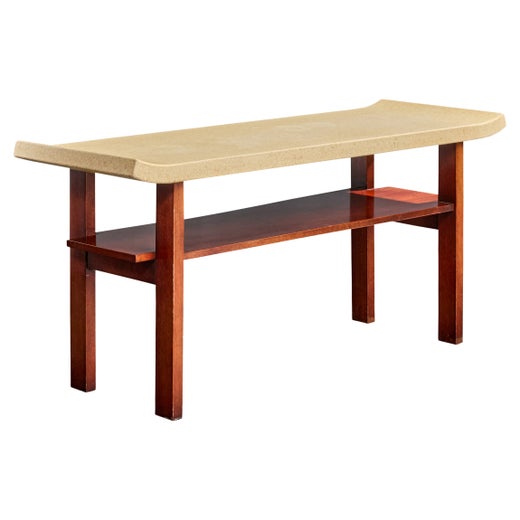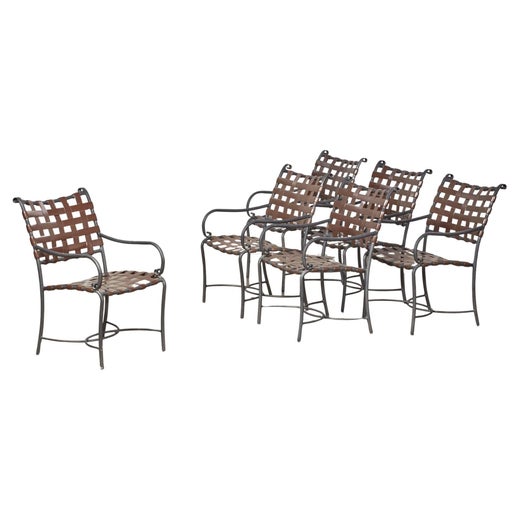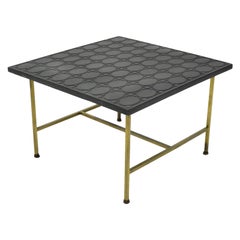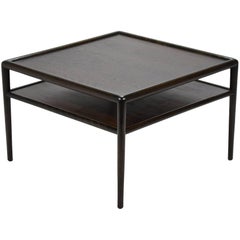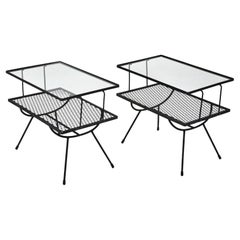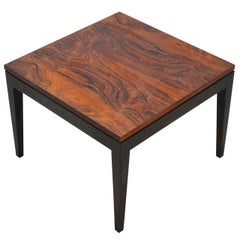Paul Frankl Two-Tiered Table by Brown-Saltman
About the Item
- Creator:Brown Jordan (Maker),Paul Frankl (Designer)
- Dimensions:Height: 27.5 in (69.85 cm)Diameter: 22.5 in (57.15 cm)
- Style:Mid-Century Modern (Of the Period)
- Materials and Techniques:Ash,Stained
- Place of Origin:
- Period:
- Date of Manufacture:1950s
- Condition:Refinished. Wear consistent with age and use. Very good condition having been newly refinished in a dark finish.
- Seller Location:Highland, IN
- Reference Number:1stDibs: LU909127976782
Paul Frankl
Born in Vienna, Paul Frankl came to the United States in 1914 as part of a wave of Central European design luminaries — among them Kem Weber, Rudolph Schindler, and Richard Neutra — who were drawn by the energy and optimism of the American scene. Prolific and protean, Frankl would go on to design furnishings that are emblematic of nearly every key stylistic chord in American modernism, from the streamlined Art Deco to free-form organic shapes.
Frankl's Skyscraper cabinets, bookcases and more — introduced in 1924 — are his earliest and best-known designs (and the work by which he is most often represented in institutions, such as New York’s Metropolitan Museum of Art). Tall and narrow, the pieces have staggered shelves meant to mimic the setbacks of Manhattan office towers. A later visually expressive line — the Speed chairs and sofas, which have a raked profile suggesting motion — links Frankl to Donald Deskey, Raymond Loewy and other creators of Streamline Moderne design.
Frankl moved to Los Angeles in 1934 and luxuriated in the climate and lifestyle. His designs became lighter and simpler and found an audience among the Hollywood élite. (Katharine Hepburn, Cary Grant and Fred Astaire were clients.) Fascinated by Asian arts, Frankl produced numerous pieces — tabletops with edges that curve upward; sofas, chairs and other seating with rattan frames — inspired by Chinese and Japanese forms and materials. In the 1940s, Frankl became one of the first designers to incorporate free-form, biomorphic shapes in his work, as well as novel upholstery fabrics such as denim and nubby wool.
Frankl biographer Christopher Long argues that the designer’s easy, elegant aesthetic had an enormous influence on movie set design. As the furniture below attests, Paul Frankl’s work is ready for its close-up.
Find vintage Paul Frankl tables, dining chairs, case pieces and storage cabinets on 1stDibs.
Brown Jordan
Pioneers of furniture designed especially for the outdoors, Brown Jordan channeled — in tables, lounge chairs and armchairs — the carefree postwar California spirit and helped create a new space in American life: the patio.
The outdoor furniture brand began to take shape in 1945, when Robert Brown, an industrial designer, and Hubert Jordan met in Pasadena, California, and began collaborating on their first design, a traditional wrought-iron breakfast set they called Morning Glory. They offered it for sale via the upscale department store Bullock’s Wilshire. The store ran an ad about the new outdoor set, and, by the end of the day, it had sold out completely.
A few years later, in 1948, the duo followed up with a new, very different design: the Leisure collection, one of the first to combine aluminum with vinyl “lace.” The materials were newly available after the war and offered a mid-century silhouette that was also lightweight and specifically designed for outdoor use. Some of Brown Jordan’s most singular pieces arose from another postwar material: Copper piping salvaged from ships that had sunk at Pearl Harbor was used to create sculptural, curvilinear outdoor furnishings as part of the Walter Lamb Bronze collection, which was first launched in the 1940s.
The Tamiami collection, by Brown Jordan in-house designer Hall Bradley, followed in the 1950s, with streamlined aluminum frames and vinyl seats and backs woven in a diagonal pattern. The line quickly became popular not only in California but across the country and on the East Coast, prompting an expansion from the original two colorways to a wider assortment of of-the-moment hues.
Brown Jordan’s offerings gained recognition as both innovations and symbols of a new kind of leisure. Tadao Inouye’s Kantan lounge chair, launched in 1956, was chosen by the Department of Commerce to be exhibited at the 1959 Industrial World’s Fair in Tokyo. In 1968, it was featured in the Cooper Hewitt’s “Please Be Seated” exhibit.
Bright colorways, metallics, pastels, powder coating and weather-ready materials became some of Brown Jordan’s hallmarks, heralding durable, design-forward furniture that helped create the modern idea of outdoor living.
Find a collection of vintage Brown Jordan furniture today on 1stDibs.
You May Also Like
Vintage 1950s American Mid-Century Modern Side Tables
Maple
Vintage 1950s American Mid-Century Modern End Tables
Maple, Cork
Vintage 1940s American Mid-Century Modern Side Tables
Glass, Oak
20th Century American Mid-Century Modern End Tables
Birch, Cork
20th Century American Mid-Century Modern Side Tables
Wood
Early 20th Century American Mid-Century Modern End Tables
Cork, Mahogany
Vintage 1950s American Mid-Century Modern End Tables
Wood
Mid-20th Century American Mid-Century Modern Side Tables
Brass
Mid-20th Century Japanese Art Deco Patio and Garden Furniture
Rattan, Oak
Vintage 1950s American End Tables
Wood
More From This Seller
View AllVintage 1950s American Mid-Century Modern Side Tables
Brass
Vintage 1950s American Mid-Century Modern End Tables
Maple, Walnut
Vintage 1950s American Mid-Century Modern End Tables
Iron
Vintage 1960s American Mid-Century Modern End Tables
Rosewood
Vintage 1970s American Mid-Century Modern End Tables
Glass, Wood
Vintage 1950s Danish Scandinavian Modern Side Tables
Brass
